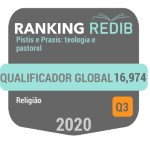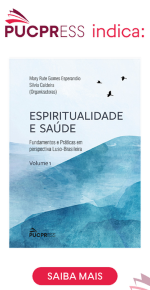Prayer and health research: proxies, missed targets, and opportunities
DOI:
https://doi.org/10.7213/revistapistispraxis.06.001.ds02Palavras-chave:
Prayer, Health, Religion, Spirituality, Methodology.Resumo
The purpose of this article is to present a quick overview of the psychology of prayer and health research in the context of the United States and Europe. Its range is limited to primarily English literature. The conclusion is that the findings are thoroughly ambiguous. It is argued that this conclusion is fundamentally inevitable because, in most instances, the variable deemed prayer is actually a proxy for a wide constellation of beliefs and behavior. Suggestions are made for re-focusing the field on scientifically feasible, theologically sensitive studies of prayer.
Downloads
Referências
AI, A. L. et al. Psychosocial adjustment and health care practices following CABG (Coronary artery bypass graft surgery). Poster session, paper presented at the annual meeting of the American Psychological Association, Toronto, Canada, 1996.
AI, A. L. et al. The role of private prayer in psychological recovery among midlife and aged patients following cardiac surgery. The Gerontologist, v. 38, n. 5, p. 591-601, 1998.
AI, A. L. et al. Spiritual well-being, private prayer, and adjustment of older cardiac patients. In: THORSON, J. A. Perspectives on spiritual well-being and aging. Springfield: Charles C. Thomas, 2000. p. 98-119.
BELL, R. A. et al. Prayer for health among U. S. adults. Complementary Health Practices Review, v. 10, p. 175-188, 2005.
BENSON, H. et al. Study of the therapeutic effects of intercessory prayer (STEP) in cardiac bypass patients: a multicenter randomized trial of uncertainty and certainty of receiving intercessory prayer. American Heart Journal, v. 151, p. 934-942, 2006.
BRUMMETT, B. H. et al. Characteristics of socially isolated patients with coronary artery disease at elevated risk for mortality. Psychosomatic Medicine, v. 63, p. 273-274, 2001.
BUCK, A. C. et al. An examination of the relationships between multiple dimensions of religiosity, blood pressure and hypertension. Social Science and Medicine, v. 68, p. 314-322, 2009.
CARNEY, R. M. et al. Major depressive disorder predicts cardiac events in patients with coronary artery disease. Psychosomatic Medicine, v. 50, p. 627633, 1988.
CBS. CBS Poll: prayer can heal. 11 Feb. 2009.
DOSSEY, L.; HUFFORD, D. J. Are prayer experiences legitimate? Explore, v. 1, n. 2, p. 109- 117, 2005.
ENSTROM, J. E. Health practices and cancer mortality among active California Mormons. Journal of the National Cancer Institute, v. 81, p. 1807-1814, 1989.
ESPERANDIO, M.; LADD, K. L. Oração e saúde: questões para a teologia e para a psicologia da religião [Prayer and health: issues for theology and psychology of religion]. Horizonte: Revista de Estudos de Teologia e Ciências da Religião, v. 11, n. 30, p. 627-656, 2013.
FRANCIS, L. J.; ASTLEY, J. (Ed.). Psychological perspectives on prayer. Leominster Herefordshire: Gracewing, 2001.
GALTON, F. Inquiries into human faculty and its development. New York: Macmillan, 1883.
GORSUCH, R. L. On the limits of scientific investigation: Miracle and intercessory prayer. In: ELLENS, J. H. Miracles: God, science, and psychology in the paranormal. Westport, CT: Praeger, 2008. p. 280-299.
HOFF, A. et al. Religion and reduced cancer risk: what is the explanation? European Journal of Cancer, v. 44, p. 2573-2579, 2008.
KOENIG, H. G. et al. The relation between religious activities and blood pressure in older adults. International Journal of Psychiatry in Medicine, v. 28, p. 189-213, 1998.
LADD, K. L.; LADD, M. L. Conceptualizing prayer for an East-West dialogue and beyond. In: WEI, D.; CAIFANG, J. (Ed.). The psychology of religion: an EastWest dialogue. Beijing: Renmin University of China Press. (In press).
LADD, K. L.; SPILKA, B. The psychology of prayer: A review of the empirical literature. In: PARGAMENT, K. I.; EXLINE, J.; JONES, J. APA handbook of psychology, religion, and spirituality. Washington, DC: APA, 2012. v. 1.
LENTINE, M. et al. Peruvian shamanism in the West and coping with bulimia: a case study. Journal of Religious Studies and Theology, v. 31, n. 2, p. 165-179, 2013.
LEVIN, J. S. How prayer heals: a theoretical model. Alternative Therapies, v. 2, p. 66-73, 1996.
LUSKIN, F. Review of the effects of religious and spiritual factors on mortality and morbidity with a focus on cardiovascular and pulmonary disease. Journal of Cardiopulmonary Rehabilitation, v. 20, p. 8-15, 2000.
MEEHL, P. E. Theoretical risks and tabular asterisks: Sir Karl, Sir Ronald, and the slow progress of soft psychology. Journal of Consulting and Clinical Psychology, v. 46, p. 806-834, 1978.
MEEHL, P. E. Why summaries of research on psychological theories are often uninterpretable. Psychological Reports, v. 66, p. 195-244, 1990.
MONROE, M. H. et al. Primary care physician preferences regarding spiritual behavior in medical practice. Internal Medicine. v. 163, p. 2751-2756, 2003.
POWELL, L. H.; SHABABI, L.; THORESEN, C. E. Religion and spirituality: linkages to physical health. American Psychologist, v. 58, p. 36-52, 2003.
ROBERTS, L. et al. Intercessory prayer for the alleviation of ill health. Cochrane Database of Systematic Reviews, v. 1, 2010.
SAUDIA, T. L. et al. Health locus of control and helpfulness of prayer. Heart and Lung, v. 20, p. 60-65, 1991.
SLOAN, R. P.; BAGIELLE, E. Data without a prayer. Archives of Internal Medicine, v. 160, p. 1870, 2000.
SLOAN, R. P. Blind faith. New York: St. Martin’s Press, 2006.
SPILKA, B.; LADD, K. L. The psychology of prayer: a scientific approach. New York: Guilford, 2013.
UCHINO, B. N. Social support and physical health. New Haven: Yale University Press, 2004.
U.S. CENSUS BUREAU. Statistical Abstract of the United States: 2008. Washington, DC, 2008.
WESTON, M. J.; BETT, J. H. N.; OVER, R. Consensus opinion and observer accuracy in electrocardiography with reference to coronary arteriographic information. Internal Medicine Journal, v. 6, p. 429-432, 1976.
Downloads
Publicado
Como Citar
Edição
Seção
Licença
O(s) autor(es) transfere(m), por meio de cessão, à EDITORA UNIVERSITÁRIA CHAMPAGNAT, pessoa jurídica de direito privado, inscrita no CNPJ/MF sob o n.º 76.659.820/0009-09, estabelecida na Rua Imaculada Conceição, n.º 1155, Prado Velho, CEP 80.215-901, na cidade de Curitiba/PR, os direitos abaixo especificados e se compromete a cumprir o que segue:
- Os autores afirmam que a obra/material é de sua autoria e assumem integral responsabilidade diante de terceiros, quer de natureza moral ou patrimonial, em razão de seu conteúdo, declarando, desde já, que a obra/material a ser entregue é original e não infringe quaisquer direitos de propriedade intelectual de terceiros.
- Os autores concordam em ceder de forma plena, total e definitiva os direitos patrimoniais da obra/material à EDITORA UNIVERSITÁRIA CHAMPAGNAT, a título gratuito e em caráter de exclusividade.
- A CESSIONÁRIA empregará a obra/material da forma como melhor lhe convier, de forma impressa e/ou on line, inclusive no site do periódico da EDITORA UNIVERSITÁRIA CHAMPAGNAT, podendo utilizar, fruir e dispor do mesmo, no todo ou em parte, para:
- Autorizar sua utilização por terceiros, como parte integrante de outras obras.
- Editar, gravar e imprimir, quantas vezes forem necessárias.
- Reproduzir em quantidades que julgar necessária, de forma tangível e intangível.
- Adaptar, modificar, condensar, resumir, reduzir, compilar, ampliar, alterar, mixar com outros conteúdos, incluir imagens, gráficos, objetos digitais, infográficos e hyperlinks, ilustrar, diagramar, fracionar, atualizar e realizar quaisquer outras transformações, sendo necessária a participação ou autorização expressa dos autores.
- Traduzir para qualquer idioma.
- Incluir em fonograma ou produção audiovisual.
- Distribuir.
- Distribuir mediante cabo, fibra ótica, satélite, ondas ou qualquer outro sistema que permite ao usuário realizar a seleção da obra ou produção para recebê-la em tempo e lugar previamente determinados por quem formula a demanda e nos casos em que o acesso às obras ou produções se faça por qualquer sistema que importe em pagamento pelo usuário.
- Incluir e armazenar em banco de dados, físico, digital ou virtual, inclusive nuvem.
- Comunicar direta e/ou indiretamente ao público.
- Incluir em base de dados, arquivar em formato impresso, armazenar em computador, inclusive em sistema de nuvem, microfilmar e as demais formas de arquivamento do gênero;
- Comercializar, divulgar, veicular, publicar etc.
- Quaisquer outras modalidades de utilização existentes ou que venham a ser inventadas.
- Os autores concordam em conceder a cessão dos direitos da primeira publicação (ineditismo) à revista, licenciada sob a CREATIVE COMMONS ATTRIBUTION LICENSE, que permite o compartilhamento do trabalho com reconhecimento da autoria.
- Os autores autorizam a reprodução e a citação de seu trabalho em repositórios institucionais, página pessoal, trabalhos científicos, dentre outros, desde que a fonte seja citada.
- A presente cessão é válida para todo o território nacional e para o exterior.
- Este termo entra em vigor na data de sua assinatura e é firmado pelas partes em caráter irrevogável e irretratável, obrigando definitivamente as partes e seus sucessores a qualquer título.
- O não aceite do artigo, pela EDITORA UNIVERSITÁRIA CHAMPAGNAT, tornará automaticamente sem efeito a presente declaração.






